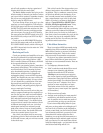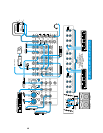
44
HOUSE AND MONITOR MIX TOGETHER
It’s a big board, but it’s the only one you own.
So you find yourself mixing house and monitors
all from the same panel.
First, let’s take a moment and set everything
up sensibly. Just like in a recording session, it’s
good to group your inputs and sub-mix buses by
instruments, stage position or whatever else
suits you. Try to keep the drum mics next to
each other, the vocals together and so on. Label
your cables, color-code your windscreens, lay
tape across the arm rest, make a cheat sheet,
iron your shorts, give yourself a break. It can be
confusing enough mixing a big show without
wondering which channel is which.
Using AUX Send-Return loops and inserting
outboard gear is the same as when recording,
unless you want to use the AUX Sends as inde-
pendent cue mixes, by engaging the PRE switch
for those AUX Sends.
Subgroups can be very helpful in Sound Rein-
forcement (SR) work. Remember, when you
assign a channel to a subgroup, de-assign that
channel from the L/R Mix.
Headphones
If you like to check things out in your phones,
and especially if you want to use the 8•Bus solo
or (modified) PFL functions as a cue circuit, set
your phones up like this:
• Be sure the MONITOR SOURCE switch is set
to what you want to listen to (usually L/R Mix,
your House feed). You can keep the two
Monitor LEVEL controls turned down,
though, because you are not feeding amplifi-
ers from the Control Room or Studio outputs.
• Plug your phones into one of the two
Phones output jacks; let’s say Phones 1.
Now select MONITOR on the PHONES 1
SOURCE switch. That should give you L/R
Mix bus plus solo. See, the solo bus only
feeds the Control Room and Studio Speak-
ers circuits, so we had to poke a few
buttons to make it work.
MAKING A SIMULTANEOUS RECORDING
You’re all set up, ready to go, when the band’s
manager comes up to you with a DAT machine
and goes “The producer wants us to send him a
recording of tonight’s gig,” and you go, “I’ll patch
it in to the house mix,” and he goes, “No, I’d
rather get a special mix just for the tape,” and
you roll your eyes and go, “You should really get
a remote truck,” and he rolls his eyes and goes,
“Here’s the tape. Make it good and we might
hire you next time.”
Piece of cake.
Refer to the drawings on pages 42 and 43.
MIX-B to the rescue! L/R Mix is your house mix,
you will use the AUX buses for stage monitor mix,
and MIX-B will provide a stereo recording feed.
Simply depress each of the MIX-B SOURCE
switches to CHANNEL, patch the MIX-B outputs
into the recorder inputs and set up your recording
mix with the MIX-B level controls. To monitor,
select MIX-B on the Phones output you’re using
and route the output of the recorder back into
EXTERNAL to check playback.
It’s true, there are no meters on the MIX-B
buses. Try using the recorder meters. If you can’t
see them from where you sit, there are a couple
of patches you can try to get metering:
• Since you’re not using the CONTROL RM or
STUDIO outputs, you can use the MONITOR
section for metering only. Simply engage only
the Mix-B Switch in that section.
• If you have two free submaster buses, patch
the MIX-B buses into the submaster insert
point. (Push the 1/4" plug only halfway in to
the Insert Jack, to the first ‘click.’ See
Appendix A: “Connections” for details.) Set
the submaster faders to –6dB to adjust for the
insert point gain difference. Now you will
have MIX-B levels showing on those two
submaster meters, and you can use the
SUBMASTER OUTPUTS as feeds to your
recorder.
• If you have the optional meter bridge fitted
and you have two extra inputs, patch the
output of MIX-B into the open channels
(either Line In or Tape In, depending on how
you have set the global source switch on the
meter bridge), set the levels at unity and
watch those two channel meters for recording
levels. You can now use the two channel’s
DIRECT OUTS as feeds to your recorder.
Make sure all the channel bus and AUX
assign switches and controls are off, so you
don’t accidentally assign your signal back into
the mix. Also, this way you could add a little
EQ or compression via the channel inserts.
• In either of the above cases, you may want
to keep the extra circuitry out of your
recording signal path. If so, just mult the
MIX-B outputs to both your recorder and to
the patch point for metering.
HOUSE MIX ONLY or MONITOR MIX
ONLY
Much easier than both at once, but requires
two mixers. Simply split the mics, set one mixer
up for house (on the L/R Mix buses, as above)
PA
&
SR


















